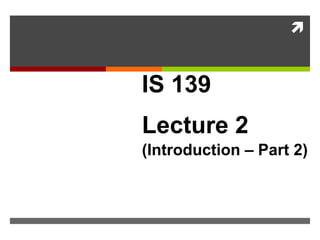
IS 139 Lecture 2 - 2015
- 1. IS 139 Lecture 2 (Introduction – Part 2) Introduction
- 2. The Computer Level Hierarchy Computers consist of many things besides chips. Before a computer can do anything worthwhile, it must also use software. Writing complex programs requires a “divide and conquer” approach, where each program module solves a smaller problem. Complex computer systems employ a similar technique through a series of virtual machine layers. 2
- 3. The Computer Level Hierarchy Each virtual machine layer is an abstraction of the level below it. The machines at each level execute their own particular instructions, calling upon machines at lower levels to perform tasks as required. Computer circuits ultimately carry out the work. 3
- 4. The Computer Level Hierarchy Level 6: The User Level Program execution and user interface level. The level with which we are most familiar. Level 5: High-Level Language Level The level with which we interact when we write programs in languages such as C, Pascal, Lisp, and Java. 4
- 5. The Computer Level Hierarchy Level 4: Assembly Language Level Acts upon assembly language produced from Level 5, as well as instructions programmed directly at this level. Level 3: System Software Level Controls executing processes on the system. Protects system resources. Assembly language instructions often pass through Level 3 without modification. 5
- 6. The Computer Level Hierarchy Level 2: Machine Level Also known as the Instruction Set Architecture (ISA) Level. Consists of instructions that are particular to the architecture of the machine. Programs written in machine language need no compilers, interpreters, or assemblers. 6
- 7. The Computer Level Hierarchy Level 1: Control Level A control unit decodes and executes instructions and moves data through the system. Control units can be microprogrammed or hardwired. A microprogram is a program written in a low- level language that is implemented by the hardware. Hardwired control units consist of hardware that directly executes machine instructions. 7
- 8. The Computer Level Hierarchy Level 0: Digital Logic Level This level is where we find digital circuits (the chips). Digital circuits consist of gates and wires. These components implement the mathematical logic of all other levels. 8
- 9. The von Neumann Model On the ENIAC, all programming was done at the digital logic level. Programming the computer involved moving plugs and wires. A different hardware configuration was needed to solve every unique problem type. 9 Configuring the ENIAC to solve a “simple” problem required many days labor by skilled technicians.
- 10. The von Neumann Model Inventors of the ENIAC, John Mauchley and J. Presper Eckert, conceived of a computer that could store instructions in memory. The invention of this idea has since been ascribed to a mathematician, John von Neumann, who was a contemporary of Mauchley and Eckert. Stored-program computers have become known as von Neumann Architecture systems. 10
- 11. The von Neumann Model Properties of a von Neumann architecture Data & Instructions are stored in the same memory – are only distinguishable through usage Only a single memory space – accessed sequentially Memory is one dimensional Meaning of data is not stored with it 11
- 12. The von Neumann Model Today’s stored-program computers have the following characteristics: Three hardware systems: A central processing unit (CPU) A main memory system An I/O system The capacity to carry out sequential instruction processing. A single data path between the CPU and main memory. This single path is known as the von Neumann bottleneck. 12
- 13. The von Neumann Model This is a general depiction of a von Neumann system: These computers employ a fetch- decode-execute cycle to run programs as follows . . . 13
- 14. The von Neumann Model The control unit fetches the next instruction from memory using the program counter to determine where the instruction is located. 14
- 15. The von Neumann Model The instruction is decoded into a language that the ALU can understand. 15
- 16. The von Neumann Model Any data operands required to execute the instruction are fetched from memory and placed into registers within the CPU. 16
- 17. The von Neumann Model The ALU executes the instruction and places results in registers or memory. 17
- 18. von Neumann Models - Improvements Conventional stored-program computers have undergone many incremental improvements over the years. These improvements include adding specialized buses, floating-point units, and cache memories, to name only a few. But enormous improvements in computational power require departure from the classic von Neumann architecture. Adding processors is one approach. 18
- 19. von Neumann Models - Improvements In the late 1960s, high-performance computer systems were equipped with dual processors to increase computational throughput. In the 1970s supercomputer systems were introduced with 32 processors. Supercomputers with 1,000 processors were built in the 1980s. In 1999, IBM announced its Blue Gene system containing over 1 million processors. 19
- 20. Non-von Neumann Models Typed storage (self-identifying data) Each operand (data item) carries bits to identify its type Programs that operate on structures rather than words Functional approach Replacing computation as a sequence of discrete operations Data flow model – order of execution depends on data interdependence 20
- 21. Conclusion & Further reading You should now be sufficiently familiar with general system structure to guide your studies throughout the remainder of this course. Subsequent lectures will explore many of these topics in great detail. Essentials of Computer Organization & architecture – Linda Null => Chapter 1 21
